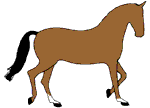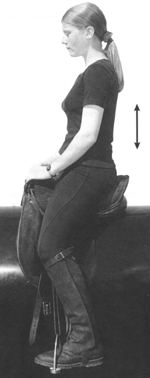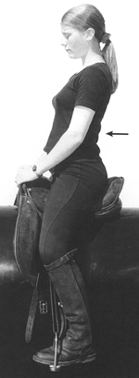Virtual Lessons - The Sitting Trot
(Reproduced with permission from the copyright owners www.newrider.com)
Firstly, it is necessary to understand how a horse moves in trot. His feet move in diagonal pairs, springing from one pair to the other, with a moment of suspension in between, so that the movement is two time- i.e. you can count one, two, one, two, in the rhythm of the stride.

For those of you without your own horse or saddle, you can still practise it at home on a stool. If the rider is to sit easily in the saddle, as if softly glued to it, then the only way that this can happen is if the rider is totally synchronising his own lower back and pelvis to mirror the undulations of the horse's back. Sitting on a stool, flex your back in, so that you emphasise the natural slight hollow in your lower back. Feel how your pelvis rocks forwards onto the front edge of your seat bones, which are shaped like the rockers of a rocking chair. Make sure that your upper body stays still, and that it is not also rocking back and forth, it is just the pelvis that should move. Now, return the pelvis to upright, so that the back is flattened again, taking care not to go past the point where it is just flat, and not rounded out the other way, so that the ribcage is collapsed. Practise this a few times, flexing the back in, then flattening, feeling your seat bones acting as a pivot point on the stool.

Back flat - pelvis upright

Back flexed in - pelvis tilted forward
This is the main movement used in absorbing all of the upwards and downward undulations of the horse's back. In essence, by flexing the spine in, you are shortening your spine by the same amount as the horse's back is rising, and by straightening the spine, you are lengthening it again, by the same amount that the horse's back is falling, in that way, the seat remains softly on the saddle, neither bouncing, nor gripping. The horse's back does not only move up and down, but also from side to side.
On the stool, place your hands on your hips, so that you can feel your hipbones. Practise tilting the top of your right hipbone forward as you flex your spine in, so that you feel your right seat bone tip onto the front edge of it's 'rocker', then bring the right hipbone back to upright, so that your spine is straight again, next tipping the left hipbone forward, flexing in your back, then bringing it back to upright again, straightening the spine. Put these four movements together, and it will feel like the four beats of the horse's walk. Now speed it up to the two time rhythm of the trot! Place your fingers on your hipbones again, and count one, two, one, two, out loud, pushing your left hip forward on the 'one', and your right hip forward on the �two, also flexing your lower back in and out slightly in the rhythm of the one, two.
When practising sitting trot, it is important not to try to achieve too many strides at first. Most riders find it difficult to co-ordinate for more than half a dozen or so strides to start with, and the longer the duration of the trot, the rider starts to bounce, so the horse stiffens up his back muscles against the discomfort of the rider's seat thumping the saddle, so that the trot becomes even harder to adhere to. Do lots of transitions (changes of pace) between walk and trot, which will also greatly benefit your horse, ensuring that his stride stays soft and springy, therefore making it easier for you to sit to anyway. Do hold onto the strap on the front of the saddle, as when your hands stay down, invariably, so does your backside!
Gradually build up until you can maintain ten or twelve strides, then fifteen or sixteen, and so on, until, before you know it, you will be able to sit comfortably to the trot for as long as you need to when schooling or in a lesson.
 Uncle Nev's Trail Rides
Uncle Nev's Trail Rides



